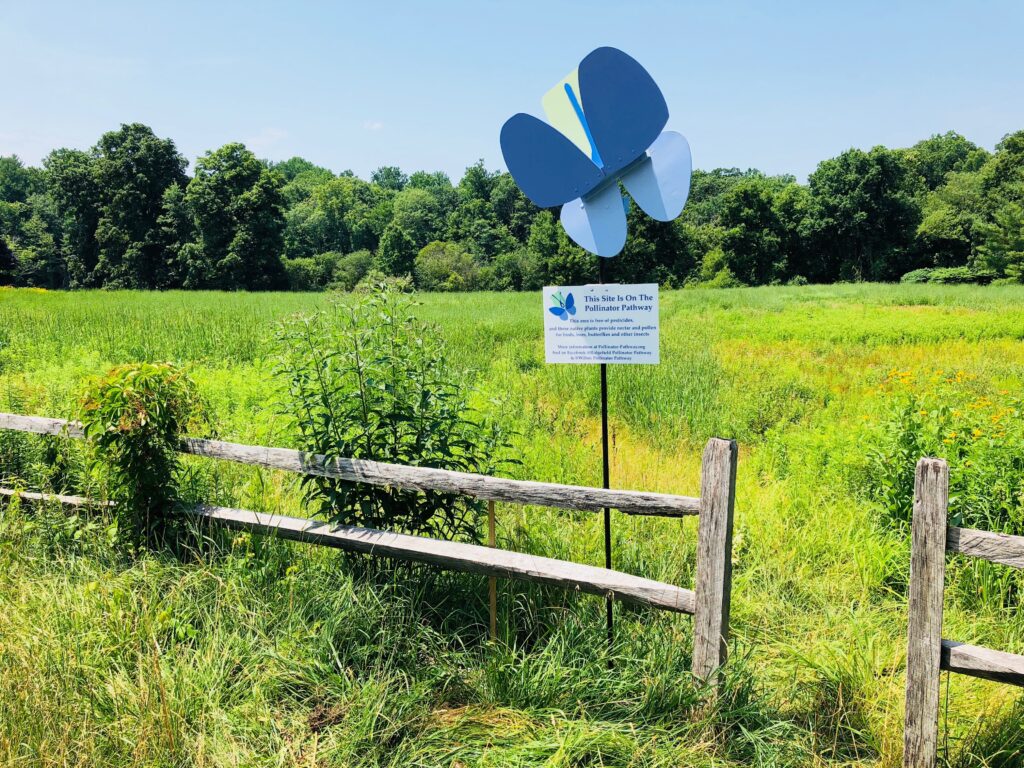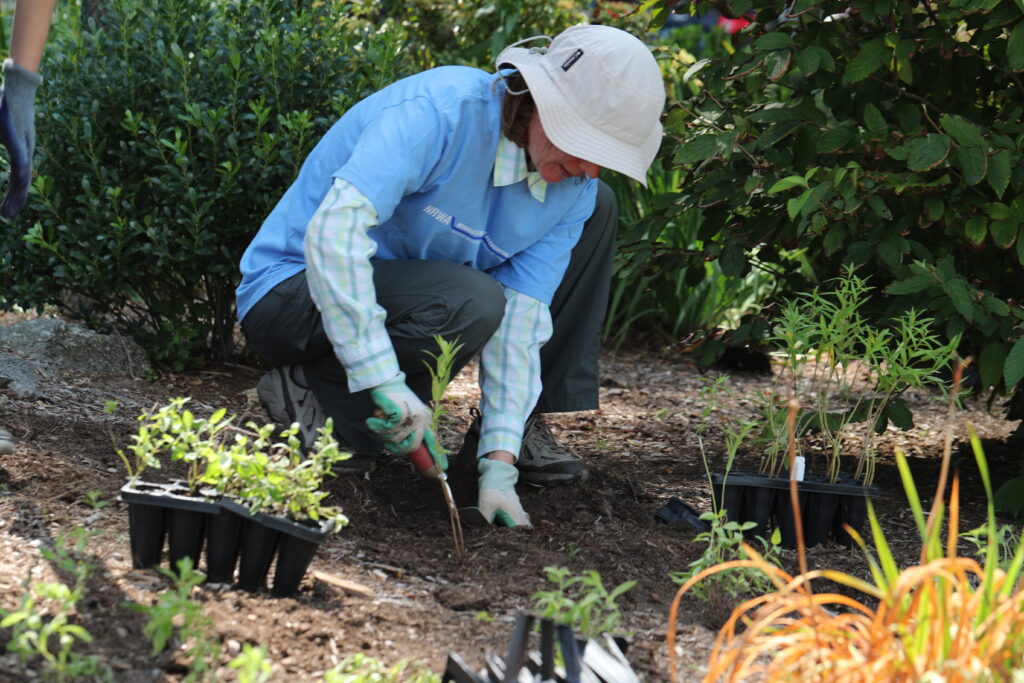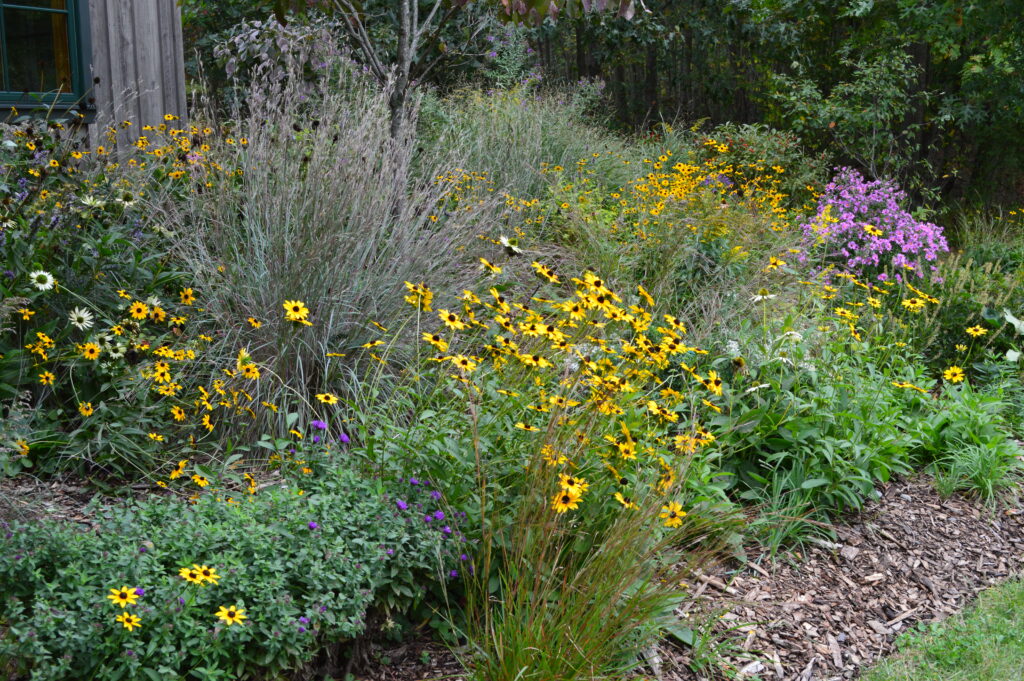Highstead’s long standing commitment to using and modeling best practices for stewarding the ecological integrity of the land begins on its site in Redding, Connecticut. Managing over 100 acres of fields, woodlands, and meadows involves many decisions that consider the surrounding ecosystem and health of local plants and animals. One of these management priorities includes protecting and enhancing habitat and food sources for pollinators that carry out services vital to plant reproduction and food production.
In honor of National Pollinator Week (June 21-27, 2021), we are sharing a few examples of how you can support healthy habitat and sustenance for pollinators at home and in your community by participating in a Pollinator Pathway.

Pollinator Pathways are a compilation of different landscapes such as pesticide-free yards and public spaces that together build a corridor of healthy habitat for pollinators and people. These series of adjacent properties are often found in urban and suburban areas where development and other land use types have eliminated natural pollinator habitat. You can support your local pollinators by planting and caring for your home landscape in a way that expands and enhances an environment suitable for bees, insects, and butterflies by incorporating three key components of the Pollinator Pathway: plant natives, no pesticides, and rethink your lawn.
“You look at the surrounding landscape, how the different habitats are interconnected, and observe the ecological processes and what nature does naturally. ”
Kathleen Kitka, Landscape and Collections Manager, Highstead
1. Plant Natives
Changing what you plant on your property or in your planters can serve to counteract habitat loss from suburban, urban, and rural development which is further exacerbated by climate changes.
You can start by planting native flowers, trees, and shrubs that are well adapted to the local climate, soils, and ecological process which provide food and habitat for the specific pollinating insects in the region. These plantings can be of various flower shapes, sizes, and colors to attract coevolved insects and pollinators. Planting for a succession of blooms that start in early spring and continue through autumn makes food and habitat available for insects in every stage of their lifecycle.

In addition to the gently managed existing native flora on the Redding property, Highstead is a part of the Ecotype Seed Project, a collaborative effort to expand healthy pollinator habitat by collecting native plant seeds from local sources and making them available to nurseries and gardeners.
2. No Pesticides
You can combine planting natives with an approach that excludes the use of synthetic chemical pesticides of any kind (insecticides, herbicides, fungicides, etc.) Since pollinators are mobile across the landscape, they can be unintentionally exposed to pesticides when passing through a sprayed lawn or property. For example, if you’re trying to treat lawn grubs with an insecticide, pollinating bees and butterflies may be unintentionally exposed to harmful chemicals, and bees may carry the exposure back to their colonies. This is thought to be a contributing factor to honey bee Colony Collapse Disorder.
When it comes to pesticides, Highstead aims for an all-organic approach wherever possible. Avoiding synthetic pesticides works hand in hand with holistically managing the landscape in regenerative ways and encouraging the natural healing processes inherent within the ecosystem. While an all-organic approach may not be realistic for your situation or your landscape, you can steward your land along organic guidelines like those provided by the Northeast Organic Farming Association in the NOFA Standards for Organic Land Care.

3. Rethink Your Lawn
The traditional turf grass lawn doesn’t offer much nutrition, hiding spaces, or habitat for small wildlife and pollinators. However, by rethinking your lawn maintenance, you can enhance your landscape’s value for wildlife and people.
Consider limiting your turf grass to areas where it serves a functional role such as a path or play area and allow other areas to grow. At Highstead, we have reduced the extent of mowing to areas immediately adjacent to our barn and what is used for paths and parking areas.
Cut your grass less frequently, raise the height of your mower, and don’t kill the broad-leafed or non-grass plants when they sprout. These steps will allow flowering plants that are beneficial to pollinators to co-exist with your lawn grasses. For example, dandelions and violets are often food sources for early hatchers. These flowers are sources of food for pollinators that pass through your neighborhood.

There are other approaches to mowing. Cut grass at a longer height and keep the edges unshorn to provide an opportunity for pollinators to find something rather than nothing. After mowing, leave clippings on the grass as a fertilizer instead of applying additional chemicals. In the autumn, leave some leaf litter in flower beds as over-wintering insect habitat, and then mow the remaining leaves in place to build the organic matter in your soil.
Highstead’s Landscape and Collections Manager Kathleen Kitka shares her approach, “You look at the surrounding landscape, how the different habitats are interconnected, and observe the ecological processes and what nature does naturally. For example, we don’t rake our leaves, cut back our perennials, or mow the wildflower meadow in the fall. We leave all that because it is food or over-wintering habitat for wildlife. Cutting it all up would disturb that.”